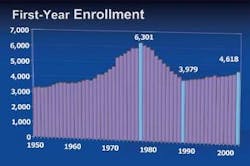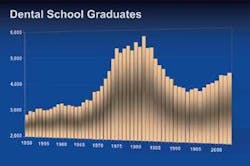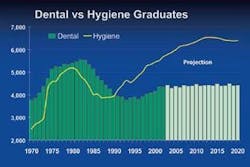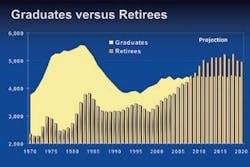THE FUTURE OF dentistry
By Eric S. Solomon, DDS, MA
Part 1 of a 4-part series
Dentistry is going through a transition. As we shall see, the range of dental services and the mix of dental practice employees have changed dramatically during the past half century. We also are experiencing a major shift in the number of dental care providers. What will the dental practice of the future look like? Here we will look at historical data and projections in the hopes that they will provide us with insights into the dental practice of the future. Our glimpse into the future has four parts: dental enrollment trends, dental manpower trends, dental economic trends, and dental practice trends. From these data, we can draw inferences about the dental practice of the future.
Dental enrollment is a great place to start our investigation. Educational programs represent the entry into the profession for most of the dental health care team. In addition, dental program graduates are the principal input variable for dental manpower models. First-year enrollment in dental schools represents the first step in the future dentist's career. Since 1950, first-year dental school enrollments have gone through four distinctly different periods (Figure 1). Between 1950 and 1965, first-year enrollment increased slowly from 3,226 to 3,808 (18 percent); that's an increase of about 1.2 percent a year. During this period of time, new dental schools were established. The number of dental schools increased from 42 to 49 (16.7 percent) in 1965 due, in part, to an influx of federal support. The baby boomer generation attended dental school between 1965 and 1978. This period is marked by rapid growth in first-year enrollment, increasing from 3,808 to 6,301 (65.6 percent) — an average annual increase of 5 percent. New dental schools continued to open, reaching a total of 60 in 1978. During the next period between 1978 and 1989, the rapid rise in enrollment in the previous decade was matched with an equally dramatic decline. By 1989, first-year enrollment had fallen to 3,979 — a decrease of 2,322 students (36.9 percent). A precipitous drop in the number of applicants to dental schools and the withdrawal of federal support for enrollment expansion fueled the decline. By 1989, five dental schools had closed or were in the process of closing. First-year enrollment has increased slowly since 1989, rising to 4,618 in 2003 (639 students). That's an average annual increase of 1.1 percent per year. In comparison, the increase in the U.S. population during this period was just more than 1.2 percent per year. During this time, one additional dental school closed and three new schools opened.
As one might expect, the pattern of dental school graduates follows that of first-year enrollment (Figure 2) — more than 90 percent of entering dental students complete the program. Two periods here are noteworthy. During the 10-year period from 1975 through 1984, the number of dental school graduates exceeded 5,000 per year, peaking at 5,756 in 1982. In contrast, between 1990 and 1996, there were fewer than 4,000 graduates per year. In 2003, there were 4,443 U.S. dental school graduates — about the same level of graduates experienced during the early 1970s.
Figure 3 shows dental school graduates and dental hygiene graduates projected to the year 2020. The number of dental school graduates is expected to remain fairly constant during the next 18 years. There are several reasons for this estimate. It is unlikely that new dental schools will open in the near future. The three schools that recently opened are located in high population growth areas, and two of them are in states that did not previously have a dental school. In addition, existing dental schools are unlikely to increase their enrollments. Today, dental schools are in a restricted fiscal condition because of cutbacks in state funding and the need to control tuition increases. Enrollment expansion is a costly proposition because it generally involves the renovation or replacement of existing facilities. In addition, many schools are focused on a more pressing problem — maintaining a quality faculty. As long as the primary site for providing clinical education is in the dental school, the number of graduates is unlikely to increase significantly for the foreseeable future.
The trend in dental hygiene graduates mirrors the dental graduates until 1990. At that point, the number of dental school graduates stabilizes and hygiene graduates increase significantly. Between 1990 and 2002, hygiene graduates increase from 3,953 to 5,693 — an increase of just more than 44 percent. This trend should continue for at least the next decade. The demand for dental hygiene services remains high. In addition, the cost of educating a dental hygienist has decreased because of a change in the educational setting for the training of dental hygienists. In 1967, almost 40 percent of dental hygiene programs were located in dental schools. In 2002, less than 10 percent of the dental hygiene programs were located in dental schools, and almost 74 percent of the programs were located in two-year institutions such as community colleges and technical schools. By 2020, 44 percent more hygienists than dentists could graduate.
In Figure 4, we compare the projected number of graduates to the projected number of dental retirees. Until about 2007, the number of dental graduates exceeds the number of dentists who retire. Around the year 2007, the number of dental retirees probably will exceed the number of dental graduates as many of the baby boomer dentists begin retirement. The graph clearly shows how the enrollment bulge of the 1970s and early 1980s is mirrored in the retirement bulge that will take place during the next 15 to 20 years. Economic conditions will impact the accuracy of the projected number of retirees. Favorable economic conditions could result in a higher number of retirees at an earlier time. Still, poor economic conditions could significantly reduce the retirement rate of dentists during the next decade.
Dental retirements vs. graduates will impact dental manpower projections. When the number of retirees exceeds the number of dental school gradates, it will impact the future of dental manpower in the United States. The next article in this series will explore manpower projections and look at the manpower implications of changes in different segments of the dental population.




